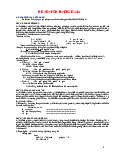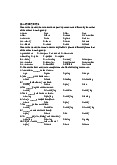





Preview text:
1
Comparing E-Commerce Determinants in Online Consumer Behavior Lai Ho Nguyet Minh - 22204296
Faculty of Languages International Cultures, Hoa Sen University
Critical Reading and Writing: 1024 - 2333 Dr. Nguyen Van Chuong June 28, 2024 2
Comparing E-Commerce Determinants in Online Consumer Behavior Introduction
Today’s world is characterized by a digital revolution, especially in terms of e-commerce.
The expansion of e-commerce across the world enhances the relevance of identifying factors that
affect consumers’ willingness to shop online to optimize product placement. This essay reviews
two academic journal articles focused on this issue: Some of the existing literature are: “Impact
on E-Commerce towards Online Shopping and Customer Buying Behavior'' by K. Selvaraju and
Karthikeyan Parthasarathy in 2016 and “Factors Affecting Consumer’s Online Shopping Buying
Behavior'' by Anurag Pandey and Jitesh Parmar in 2019. The first article is an overview of the
effects that e-commerce development has had on shopping whereas the second is truly
multidimensional in that it presents individual maneuvers which have a direct influence on the
general decision making that takes place when shopping online. In this essay, the studies will be
compared according to their aims and methods, as well as major conclusions, to assess present
tendencies and sources affecting the consumer behavior online. Body Research Objectives
The objective of the study of Selvaraju and Parthasarathy in their research paper is
defined by two research questions: The impact of e-commerce on the consumer buying behavior
and The factors influencing purchase behavior on e-commerce. They try to determine factors like
ease of access, diversification, and convenience relating to the consumer. On the other hand, Pandey and 3
Parmar (2019) are interested in the psychological and social factors affecting online
shopping behavior with the objective of establishing certain antecedents that include perceived
trust, perceived risks and social pressures on consumers’ buying behavior.
Selvaraju and Parthasarathy paint a more comprehensive picture of how e-commerce
alters the consumer climate, whereas Pandey and Parmar analyze the consumers’ mind-set in
greater detail. The fact that these factors are not common enables the two studies to provide
insight on the characteristics and influences of online shopping separately. The former relates to
the consumer decision making on the macro level while the latter gives a micro view of the same. Findings
According to Selvaraju and Parthasarathy (2016), the three key reasons that consumers
patronize the Internet for shopping include convenience, variety and easy comparison of price.
This means that the consumer population is shifting towards e-commerce stores because one can
shop from any location at their own convenience, there is a greater variety of the products, and
because it is easy to compare prices.
Pandey and Parmar (2019) revealed that trust and perceived risk were important factors
affecting online shopping. The level of reliability and security perceived by consumers about the
online retailer and the process has impacted the tendency of the consumers to purchase goods.
On the other hand, perceived risk, which could be the quality of the product, security of the
firm’s data, etc. can also make consumers refrain from purchasing from online stores. Their
studies debunk the myth about the online consumer being less concerned with the elements of
perceived risk and stressed the need for developing trust mechanisms that are key determinants of purchase intentions. 4
These findings thus establish similarities and differences. The two papers acknowledge
that trust plays an instrumental role in the pursuit of online shopping. However, while
convenience and product differentiation are important in Selvaraju and Parthasarathy’s work,
Pandey and Parmar have defined the restrictive psychological factors for online purchasing. Discussion
Selvaraju and Parthasarathy (2016) hold the opinion that e-commerce should maintain the
improvement of convenience factors and widen the range of goods to gain more consumers.
Pandey and Parmar (2019), on the other hand, focus on consumers’ trust as a critical component
required for e-commerce platforms. This is due to the proposals they make regarding the security
measures that should be adopted, the information that should be posted, and the general
promotion of crowded interactions such as reviews and ratings. They touch on perspectives of
thoughts, noting that dealing with the psychological states of consumers, especially issues of
trust and risk, is vital with regard to creating a healthy shopping climate.
Therefore, the comparison of these articles gives a complex picture of the consumers’
behaviors in the Internet environment. Whereas, the study of Selvaraju and Parthasarathy offers a
general view of the characteristics that define the motive behind shopping online, the work of
Pandey and Parmar gives more extensive information on the psycho factors that affect the
purchasing behavior of consumers. Conclusion
In conclusion, these articles reduce the weaknesses of the Selvaraju and Parthasarathy
(2016) and Pandey and Parmar (2019) articles in improving the understanding of online
consumer behavior. Selvaraju and Parthasarathy indicate the importance of convenience, and
accessibility of e-commerce products and provide real-life tips on how to increase customers’ 5
satisfaction. Nevertheless, their broad approach could be made deeper with more variables analysis types.
On the other hand, the new factors that are considered developed by Pandey and Parmar
including trust, perceived risk and social influence are grounded in psychology, which offers
another insightful view on consumers’ decision making. Their choice of structural equation
modeling is one of the study’s strong points, they could possibly increase the number of
participants in their sample to provide even more enriched insights into the topic.
Altogether, the offered studies provide a holistic vision of the state of affairs with online
purchasing, stressing compliance with the principles of convenience and trust. The evidence
presented by both authors provide useful tips to the e-commerce managers who are interested in
improving the company’s relations with customers and creating positive feelings in the target audience. 6 References
Pandey, A., & Parmar, J. (2019). Factors affecting consumer's online shopping buying
behavior. In Proceedings of 10th international conference on digital strategies for organizational success.
Selvaraju, K., & Karthikeyan, P. (2016). Impact on E-Commerce towards Online
Shopping and Customer Buying Behavior. Asian Journal of Research in Social Sciences and Humanities, 6(7), 1260-1270.




